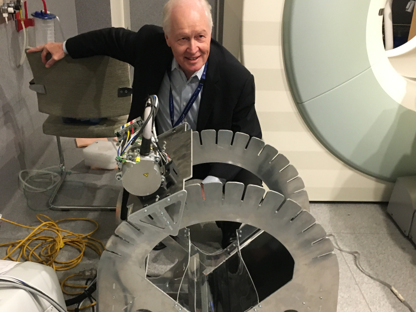AUSTRALIAN TECHNOLOGY IN BID TO DELIVER STROKE DIAGNOSIS INTO EVERY AMBULANCE

Dr. Geoffrey Donnan, MBBS, MD, FRCP, FRACP, FAAHMS
Professor of Neurology, University of Melbourne, Melbourne Brain Centre, Royal Melbourne and Austin Hospitals. First prototype scanner, conventional CT shown in background.
Micro-X, an Adelaide based company is working as part of the Australian Stroke Alliance to develop a lightweight mobile CT scanner ‘Ring Scanner’ to enable lifesaving diagnostic imagers to be fitted into every ambulance providing stroke diagnosis at the point-of-care.
Stroke is a leading cause of death and long-term disability in Australia and second highest cause of death globally. By speeding up stroke diagnosis time, vital pre-hospital treatment can begin. The introduction of a small CT scanner into ambulances will ensure the appropriate treatment can be provided earlier, improving patient outcomes and reducing long-term healthcare costs.
Micro-X’s ‘Ring Scanner’ aims to provide comparable diagnostic imaging to a conventional head CT scan in a unit small enough and at a price point where one can be fitted in every ambulance. The goal is for the majority of stroke patients to be treated within the ‘Golden Hour’. The ‘Ring Scanner’ will also be light enough to be deployed in fixed or rotary wing air ambulances.
Micro-X, a member of the Australian Stroke Alliance, led by clinical specialists from the Royal Melbourne Hospital, has been successful in conducting a feasibility phase on their ‘Ring Scanner’ concept with stage 1 funding. The alliance is now pitching for a share of the Frontier Health and Medical Research initiative funded by the Federal Government Medical Research Future Fund to bring this product to market.
Micro-X, the only company to have commercialised carbon nanotube emitter technology (CNT) in x-ray imaging, now has 2 launched products and has proven the technology with units operating in 14 countries around the world. This history of successful commercialisation places Micro-X in a strong position to develop, manufacture and bring this revolutionary new product to market.
Micro-X’s Managing Director, Peter Rowland commented:
“Micro-X is thrilled to be part of the Stroke Alliance’s bid to revolutionise stroke treatment. As a successful manufacturer of innovative health imaging technology, we are committed to turning bold ideas into global impact. We believe so much in this project and have invested in research and global partnerships to ensure we can develop high-quality brain images that detect small brain bleeds – all packaged in a device that can be fitted into any ambulance or aircraft. Winning the next stage of funding for this exciting project will not only improve the health outcomes of thousands of Australians, but also have an enormous economic benefit through job creation in manufacturing and research development.”
Stroke is highly treatable but time critical, with the “golden hour” after onset the vital window for receiving diagnosis and treatment to give patients the best chance of survival and full recovery.
Micro-X has also partnered with Monash University in developing the workflow of the Ring Scanner, Dr Nyein Chan Aung, Senior Design Research Officer, Monash Design Health Collab at Monash Art Design & Architecture, Monash University commented:
“Design is the interface between technology and the user. The Monash Design Health Collab team is using design research methods to understand the user behaviour of medical professionals profoundly and to respond with design interventions that will streamline the usability of our mobile stroke imaging technology – down to the second.”
Time is critical when someone is having a stroke, that’s why it’s important this collaboration of leaders from across Australia are coming together and addressing urgent research to develop world-first disruptive technologies to radically transform access to early pre-hospital treatments and to dramatically improve stroke outcomes for all Australians.
The Australian Stroke Alliance includes experts from health and academic institutes and charities, including the Royal Melbourne Hospital, University of Melbourne, Ambulance Victoria, Stroke Foundation and Royal Flying Doctors Service.
The Need
More than 15 million people worldwide each year will get a stroke; 5 million will die and another 5 million will be permanently disabled.
The number of strokes worldwide continues to rise each year, and a Covid-19 has resulted in a significant increase in the number of strokes.
Early intervention is key to reducing deaths, reducing disability, and increasing positive patient outcomes.
Mobile Stroke Units bring critical CT imaging directly to the patient to accelerate life-saving intervention.
Conventional CT technology’s size, weight, and work-flow prohibit the widespread deployment of Mobile Stroke Units.
Micro-X Solution
Micro-X’s unique CNT x-ray technology can be leveraged to dramatically reduce the size, weight, and complexity of CT imaging.
When combined with an innovative imaging approach, a CNT based CT could deliver fast accurate brain imaging directly to a stroke patient.
Micro-X RING SCANNER design concept is:
- Small and lightweight to be directly integrated into any road or air-ambulance, turning existing ambulances into a Mobile Stroke Unit.
- High Speed Imaging to deliver rapid high-resolution images of the brain to enable clinicians to accurately diagnose strokes.
- Full Stationary with no moving parts to enable imaging in any environment, even in movement.
- Cost Effective designed to a cost target that will enable widespread deployment of the system to ambulances globally.

